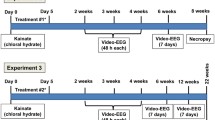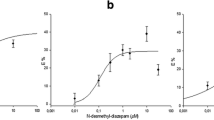Abstract
Herein, we tested in a model of generalized reflex epilepsy in mice different 1,4-benzodiazepines and 1,5-benzodiazepines with agonistic activity at the GABAA receptor population contributing to the peak component of the chloride current elicited by GABA in cerebellar granule cells (CGCs) in culture. The substances have all higher lipophilia than clobazam, an antiepileptic drug well known and used in human therapy. This ensures that they all can pass relatively easily the blood-brain barrier (BBB). The benzodiazepines were administered intraperitoneally (i.p.) and tested for their activity against sound-induced tonic and clonic seizures in a genetic model of experimental epilepsy, the DBA/2 mouse. Our data demonstrates an interesting inverse correlation between the ED50s and the efficacy (E %) of the drugs in increasing the peak chloride current elicited by GABA in cerebellar granule cells in culture. There is indication of the existence of a threshold of E % above which the increase of ED50 with increasing E % becomes linear. This is statistically significant for the clonic phase, whereas it is at the limit of significance for the tonic one. A possible interpretation of these results is that in this epilepsy model, projections from the cerebellum exert a convulsion prevention activity.


Similar content being viewed by others
References
Brickley SG, Cull-Candy SG, Farrant M (1996) Development of a tonic form of synaptyc inhibition in rat cerebellar granule cells resulting from persistent activation of GABAA receptors. J Physiol 497:753–759
Cook PM, Snider RS (1955) Some cerebellar influences on electrically-induced cerebral seizures. Epilepsia 4:19–28
Cooper IS, Amin I, Gilman S (1973) The effect of chronic cerebellar stimulation upon epilepsy in man. Trans Am Neurol Ass 98:192–196
Cooper IS, Amin I, Riklan M, Waltz JM, Poons TP (1976) Chronic cerebellar stimulation in epilepsy. Clinical and anatomical studies. Arch Neurol 33:559–570
Cox JH, Seri S, Cavanna AE (2014) Clinical utility of implantable neurostimulation devices as adjunctive treatment of uncontrolled seizures. Neuropsych Dis Treat 10:2191–2200
De Sarro GB, Di Paola EG, Aguglia U, De Sarro A (1996a) Tolerance to anticonvulsant effects of some benzodiazepines in genetically epilepsy prone rats. Pharm Biochem Behav 55:39–48
De Sarro GB, Gitto R, Rizzo M, Zappia M, De Sarro A (1996b) 1,4-Benzodiazepine derivatives as anticonvulsant agents in DBA/2 mice. Gen Pharmacol 27:935–941
De Sarro G, Russo E, Citraro R, Meldrum BS (2015) Genetically epilepsy-prone rats (GEPRs) and DBA/2 mice: two animal models of audiogenic reflex epilepsy for the evaluation of new generation AEDs. Epilepsy & Behavior In Press
Farrant M, Nusser Z (2005) Variations on an inhibitory theme: phasic and tonic activation of GABAA receptors. Nat Rev Neurosci 6:215–229
Gatta E, Cupello A, Di Braccio M, Grossi G, Ferruzzi R, Roma G, Robello M (2010) New 1,5-benzodiazepine compounds: activity at native GABAA receptors. Neuroscience 166:917–923
Gatta E, Cupello A, Pellistri F, Robello M (2009) GABAA receptors of cerebellar granule cells in culture: explanation of overall insensitivity to ethanol. Neuroscience 162:1187–1191
Hester JB, Rudzik AD, Kamdar BV (1971) 6-phenyl-4H-s-triazolo[4,3-a][1,4]benzodiazepines which have central nervous system depressant activity. J Med Chem 14:1078–1081
Hobbs WR, Rall TW, Verdoorn TA (1996) Hypnotics and sedatives; ethanol. In: Hardman JG, Limbird LE, Molinoff PB, Ruddon RW, Goodman Gilman A (eds) The pharmacological basis of therapeutics. McGraw-Hill, New York
Laxer KD, Robertson LT, Julien RM, Dow RS (1980) Phenytoin: relationship between cerebellar function and epileptic discharges. Adv Neurol 27:415–427
Lehay JT, Chu-Shore CJ, Fisher JL (2011) Clobazam as an adjunctive therapy in treating seizures associated with Lennox-Gastaut syndrome. Neuropsychiat Dis Treat 7:673–681
Levi G, Aloisi F, Ciotti MT, Gallo V (1984) Autoradiographic localization and depolarization-induced release of acidic amino acids in differentiating cerebellar granule cells cultures. Brain Res 290:77–86
Luddens H, Pritchett DB, Kohler M, Killish I, Keinamen K, Monyer H, Sprengel R, Seeburg PH (1990) Cerebellar GABAA receptors selective for a behavioral alcohol antagonist. Nature 346:648–651
Mohler H (2006) GABAA receptor diversity and pharmacology. Cell Tissue Res 326:505–516
Mohler H (2015) The legacy of the benzodiazepine receptor: from flumazenil to enhancing cognition in down syndrome and social interaction in autism. Adv Pharmacol 72:1–36
Moruzzi G (1941) Sui rapporti tra cervelletto e corteccia cerebrale: azione di impulsi cerebellari sulle attività motorie provocate dalla stimolazione faradica o chimica del giro sigmoideo nel gatto. Arch Fisiol 41:157–182
Mutani R, Bergamini L, Doriguzzi T (1969) Experimental evidence for the existence of an extra-rhinencephalic control of the activity of the cobalt epileptogenic focus. Part 2. Effects of the paleocerebellar stimulation. Epilepsia 10:351–362
Nikas P, Gatta E, Cupello A, Di Braccio M, Grossi G, Pellistri F, Robello M (2013) Modulation of native GABAA receptor activity by triazolo 1,5-benzodiazepines. Neuroscience 243:158–164
Nikas P, Gatta E, Cupello A, Di Braccio M, Grossi G, Pellistri F, Robello M (2015) Study of the interaction of 1,4- and 1,5-benzodiazepines with GABAA receptors of rat cerebellum granule cell in culture. J Mol Neurosci 56:768–772
Palacios JM, Kuhar MJ (1981) Ontogeny of high-affinity GABA and benzodiazepine receptors in the rat cerebellum: an autoradiographic study. Brain Res 254:531–539
Riss J, Cloyd J, Gates J, Collins S (2008) Benzodiazepines in epilepsy: pharmacology and pharmacokinetics. Acta Neurol Scand 118:69–86
Robello M, Amico C, Cupello A (1993) Regulation of GABAA receptors in cerebellar granule cells in culture: differential involvement of kinase activities. Neuroscience 53:131–138
Rossi GF, Coloicchio G, Scerrati M (1987) La stimolazione cerebellare cronica nel trattamento dell’epilessia farmaco resistente. Boll Lega Ital Epil 60:5–12
Rossi S, Pirola O, Maggi R (1969) Sintesi di 1,2,4,5-tetraidro-2,4-dicheto-3H-1,5-benzodiazepine. Chim Ind 51:479–483
Rudolph U, Knoflach F (2011) Beyond classical benzodiazepines: novel therapeutic potential of GABAA receptor subtypes. Nat Rev Drug Discov 10:685–697
Russo E, Paola ED, Gareri P, Siniscalchi A, Labate A, Gallelli L, Citraro R, De Sarro G (2013) Pharmacodynamic potentiation of antiepileptic drugs’ effects by some HMG-CoA reductase inhibitors against audiogenic seizures in DBA/2 mice. Pharmacol Res 70:1–12
Sankar R (2012) GABAA receptor physiology and its relationship to the mechanism of action of the 1,5-benzodiazepine clobazam. CNS Drugs 26:229–244
Saxena NC, Macdonald RL (1996) Properties of putative cerebellar gamma-aminobutyric acid a receptor isoforms. Mol Pharmacol 49:567–579
Schmidt D (2002) Benzodiazepines: clinical efficacy and use in epilepsy. In: Levy RH, Mattson RH, Meldrum BS, Perucca E (eds) Antiepileptic drugs. Lippincot Williams & Wilkins, Philadelphia, PA, pp. 206–214
Sigel E, Steinmann ME (2012) Structure, function and modulation of GABAA receptors. J Biol Chem 287:40224–40231
Sternbach LH, Reeder E (1961) Quinazolines and 1,4-benzodiazepines. IV. Transformations of 7-chloro-2-methylamino-5-phenyl-3H-1,4-benzodiazepine 4-oxide. J Org Chem 26:4936–4941
Sternbach LH, Fryer RI, Metlesics W, Reeder E, Sach G, Saucy G, Stempel A (1962) Quinazolines and 1,4-benzodiazepines. VI. Halo-, methyl-, and methoxy-substituted 1,3-dihydro-5-phenyl-2H-1,4-benzodiazepin-2-ones. J Org Chem 27:3788–3796
Sternbach LH, Fryer RI, Metlesics W, Reeder E, Sach G, Steiger N (1963) Quinazolines and 1,4-benzodiazepines. X. Nitro-substituted 5-phenyl-1,4-benzodiazepine derivatives. J Med Chem 6:261–265
Unnerstall JR, Kuhar MJ, Niehoff DL, Palacios JM (1981) Benzodiazepine receptors are coupled to a subpopulation of gamma-aminobutyric acid (GABA) receptors: evidence from a quantitativeautoradiographic study. J Pharmacol Exp Ther 218:797–804
Velasco F, Carrillo-Ruiz JD, Brito F, Velasco M, Velasco AL, Marquez I, Davis R (2005) Double-blind, randomized controlled pilot study of bilateral cerebellar stimulation for treatment of intractable motor seizures. Epilepsia 46:1071–1081
Author information
Authors and Affiliations
Corresponding author
Ethics declarations
Conflict of Interest
The authors declare no conflict of interest.
Rights and permissions
About this article
Cite this article
Gatta, E., Cupello, A., Di Braccio, M. et al. Anticonvulsive Activity in Audiogenic DBA/2 Mice of 1,4-Benzodiazepines and 1,5-Benzodiazepines with Different Activities at Cerebellar Granule Cell GABAA Receptors. J Mol Neurosci 60, 539–547 (2016). https://doi.org/10.1007/s12031-016-0838-0
Received:
Accepted:
Published:
Issue Date:
DOI: https://doi.org/10.1007/s12031-016-0838-0




